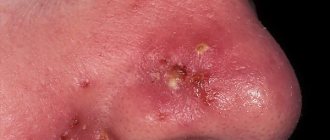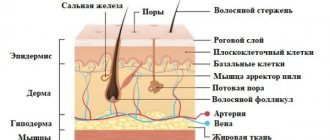The exact causes of lipoma (lat.lipoma), consisting of adipose tissue, have not yet been fully elucidated. Zhirovik is the common name for formations. As a rule, such a benign tumor grows in internal organs or is located in the subcutaneous fat. In this case, the development of fat cells present in the skin is disrupted, resulting in the development of lipomatosis. This pathology can be dangerous and cause significant discomfort. Why do wen appear?
The exact causes of lipoma have not yet been fully elucidated.
What is lipoma?
Lipoma is a benign tumor that occurs in the fatty tissue under the epidermis. Formations can occur in any part of the body where there is a fat layer.
In ordinary words, this is an uneven accumulation of adipose tissue in one place; popularly this tumor is called a wen.
It most often occurs in people over thirty years of age. This type of formation is not dangerous to human health, however, based on aesthetic opinions, it requires treatment.
Good to know! If a formation occurs, you must consult a doctor who will confirm that the tumor is benign and does not pose a health risk. After the examination, the doctor will prescribe the correct treatment to eliminate this defect.
What does it look like?
There are superficial lipomas, which are visible visually, and intramuscular ones, formed inside the muscle tissue.
The formation has the appearance of a pea or larger depending on the amount of accumulated adipose tissue, which tends to gradually increase in size.
Most often it appears in places where there is a greater accumulation of subcutaneous fat, namely:
- Hips
- Back
- Shoulders
- Breast
- Internal organs.
The disease does not cause pain; the neoplasm is elastic and soft to the touch. The internal structure of the neoplasm has separate lobules; in case of skin tension, you can visually see the boundaries of the formation.
Let's celebrate! Wen can vary in size, starting from the smallest pea-sized and ending on almost the entire surface of the body part. If a lipoma remains on the body for a long time, it tends to become harder and cause an uncomfortable feeling when in contact with clothing.
Features of lipomas:
- There are single formations or many wen are combined in one place
- In place of one wen, others of a smaller size may form
- Wen growth occurs slowly
- If the lipoma is located near blood vessels, you may feel pain when touched.
When pressing on the formation, it may move slightly under the skin.
Classification of lipomas
Lipomas can be classified as follows:
- Lipofibroma - the formation consists of adipose tissue; when touched, the softness of the wen is felt.
- Fibrous lipoma - upon examination, you can feel a denser structure, with particles of connective fibers.
- Myolipama is a tumor that, in addition to adipose tissue, also contains muscle tissue.
- Angiolipam - differs from other types of formations by the presence of a large number of capillaries in adipose tissue.
- Ring-shaped lipomas are most often observed in the neck area
- Tree-like wen that forms inside muscle tissue
- Lipomas in the form of capsules with clear boundaries
- Lipomas are diffuse, without clear boundaries
- Wen, which has a stalk-like process that contains blood vessels
- Fatty tissues that have a dense structure with a large amount of ossified substance inside.
Good to know! Medical experts believe that lipomas do not have the ability to turn into low-quality tumors, and only those lipomas that cause discomfort or have increased in size should be treated.
Clinical picture of lipomatosis
The severity of the clinical picture and the prognosis of the disease determine the nature of the pathology. A fatty tumor can form on the skin, in the membranes of the brain, in the digestive tract, mammary gland, between muscles, on internal organs, in the myocardium, bones and nerve trunks.
Lipoma is characterized by slow growth. This benign tumor is mobile and absolutely painless. Its shape usually does not change when pressed. Lipoma has clearly defined edges and a soft consistency. This type of wen does not hurt on palpation. Gradually it becomes a mobile, loose neoplasm. In some cases, lipomatosis occurs suddenly and the body temperature rises sharply. The patient's general condition deteriorates significantly.
Causes of wen
The causes of a benign tumor can be different, depending on the individual characteristics of the person and hereditary factors.
The most common reasons are:
- Compression of muscle tissue due to injury
- Diseases that are associated with metabolism in adipose tissue
- Diabetes disease
- Insufficient amounts of minerals and vitamins in the body
- Weakened immunity
- Exposure to ionizing rays
- Bad habits
- Age-related changes.
- A lot of excess weight
- Disturbances in hormonal balance
Very often, the causes of this type of formation can be problems with digestion and metabolism.
Symptoms
- Most often, the formation has the appearance of a compaction and is visually visible.
- Depending on the internal component of the lipoma, it is soft or has a slight feeling of density.
- The tumor does not cause pain when touched.
- As the formation grows, numbness in the area of origin, tingling, and sometimes nagging pain may occur.
Etiology of lipomatosis
If signs of lipoma occur, the reasons may be different.
The development of lipoma is usually associated with factors such as:
- regular overeating, unhealthy diet;
- slow metabolism;
- hormonal imbalance;
- sedentary lifestyle;
- signs of slagging in the body;
- bad habits associated with alcohol and smoking;
- stressful situations;
- body restructuring in adolescents;
- lipid metabolism disorder;
- indigestion in the body, insufficient production of protein enzymes;
- non-compliance with hygienic requirements, while the lumen of the sebaceous gland is clogged with a thick secretion;
- malnutrition.
Cases of familial lipomatosis have been described in medicine, so the role of the hereditary factor is still discussed among specialists. Often the causes of the appearance of wen are genetic abnormalities. Usually one of the patient's blood relatives has this disease.
The relationship between the patient's weight and lipoma growth has not been established. Even a thin person can develop movable tumor-like formations. Lipoma continues to accumulate fat and grow even if the patient loses a lot of weight.
Abnormalities in the pancreas are one of the causes of lipoma
If a lipoma is detected, the causes may be the following:
- pathologies of the circulatory system;
- a number of metabolic diseases;
- diabetes;
- thyroid diseases are common causes of lipoma formation;
- pituitary dysfunction;
- acne that does not heal for a long time;
- disorders in the pancreas;
- poisoning by decay products - intoxication of the body;
- various liver diseases;
- demodicosis, when a lipoma occurs due to small mites that have penetrated the sebaceous gland;
- hypofunction of the thyroid gland;
- neurotrophic processes are another reason for the appearance of lipoma.
Diagnosis of lipoma
If the wen is visually visible during diagnosis, the doctor will make a diagnosis.
If there are internal formations, diagnosis requires the use of special tools and computer diagnostics. Diagnosis of large lipomas can be carried out using the following methods:
- Ultrasound
- Biopsy
- Diagnosis using X-ray
Let's celebrate! When diagnosing a formation, an examination is carried out by palpation and the type of lipoma is identified; depending on the type of tumor, appropriate treatment is prescribed.
Is the neoplasm dangerous to health?
Wen that are small in size are not hazardous to health, but changes in size must be constantly monitored.
If the formation increases in size, you should seek medical advice.
Lipomas often appear in places that are visible to other people. Therefore, it may cause personal discomfort to the person.
In addition, with constant contact with things, a feeling of discomfort and nagging pain may appear.
Experts recommend that if any formations are detected, seek examination at a medical institution to prevent the formation of malignant tumors.
How to treat lipoma?
Before prescribing a treatment method, a person should undergo a general examination of the entire body, after which a sample is given to check for the presence of cancer cells in the formation.
After passing all the necessary tests, the doctor prescribes treatment, which is as follows:
- Monitoring the development of education - undergoing consultations in which the doctor observes changes in the size and structure of the wen
- Surgical removal is performed by surgical intervention and the accumulation of adipose tissue itself is removed.
Whatever treatment method is chosen, it is necessary to periodically see a doctor and carefully monitor the possible presence of a tumor.
Wen removal
Modern medicine makes it possible to remove the wen using several methods:
- Removal in the classical way - a small incision is made to remove the formation, after which the wen along with the capsule is removed from the site of the lesion.
- Endoscopic method - for this method, a small incision is made and the formation is destroyed, after which the wen particles are removed
- Liposuction involves aspiration of the capsule through a small incision.
Note! Most often, surgical intervention methods are used only when the wen quickly changes its size.
Treatment with folk remedies
The following methods are often used to treat lipomas with folk remedies:
- Vishnevsky ointment is applied to the site of formation and sealed with a band-aid. This compress must be left overnight. Used for small lipomas; after several days of use, the lipoma component comes out.
- Use a strong infusion of celandine. To do this, you need to boil three tablespoons of herbs per half liter and cool to room temperature. Then apply compresses to the site of formation until the contents of the wen come out.
- With the help of a golden mustache. The leaves of the plant should be mashed to a pulp and applied to the sore spot overnight, wrapping the area tightly. Use until the wen comes to the surface.
Medical specialists have a negative attitude towards traditional medicine methods and consider this method of eliminating the problem to be ineffective.
Prevention of occurrence
In order to prevent neoplasms from appearing on the body, you should follow the correct lifestyle.
It is necessary to limit the intake of harmful foods that contribute to the deposition of fatty tissue and pay great attention to physical exercise.
However, this type of formation can occur in any person; preventive measures only reduce the risk of occurrence.
The appearance of wen on the body is a fairly common problem that requires examination by a specialist. This neoplasm should not be ignored, as it may be a manifestation of cancerous tumors.
Good to know! If there is a rapid increase in the tumor, it must be removed surgically. To reduce the risk of these types of lipomas, you need to monitor proper nutrition and lead an active lifestyle.
General information about lipomastia
What is lipomastia
Lipomastia, or also called false gynecomastia, is an enlarged mammary gland.
In other words, a man becomes the owner of female breast forms. With this problem, drooping nipples are common.
False gynecomastia differs from true only in its aesthetic component. In the case of true gynecomastia, the help of an oncologist is necessary, since in this case the increase in fat is dangerous to health.
When does the disease appear?
Lipomastia appears in men at different ages.
During adolescence
For example, young men often become the owners of a mixed form, since there is not only excess weight, but also a hormonal imbalance. As you grow older, the hormonal imbalance goes away, but fat deposits must be combated.
Lipomastia of this nature is very difficult to cope with only sports and diets, since the connective tissue develops.
At a young and mature age
From the age of 20 in men, lipomastia occurs due to weight gain.
In old and senile age
Men often suffer from hormonal imbalances due to hormonal changes in the body and decreased physical activity, which also increases the risk of developing gynecomastia. And in this case, it is no longer a false form.
Causes of lipomastia
The main reason is excess body weight, a proportional increase in the number of fat cells in the chest, abdomen and thighs.
Less common is the manifestation of idiopathic false gynecomastia, i.e. growth of adipose tissue in the area of the mammary gland, at the same time the patient does not suffer from excess weight.
Consequences of the development of gynecomastia
Lipomastia does not have any effect on the well-being of men.
Of course, excess weight itself will definitely lead to a disruption in the general condition of the body, but it is the fat accumulations in the chest area that will not cause any harm to its owner.
The main problem of gynecomastia is the presence of psychological aesthetic discomfort that it brings to its owner.
In particular, it is precisely because of this discomfort that there is a small percentage of suicide among children, which is brought about by the ridicule of peers and their own dissatisfaction.
What can we say about adult men, who, in turn, are embarrassed to wear open clothes and, accordingly, appear on beaches and in swimming pools. They have difficulty establishing contact with the opposite sex, which consequently affects sexual activity and causes depression.
Symptoms and signs
Gynecomastia begins and is asymptomatic. The growth of the mammary glands usually causes a pressing sensation, and there is also a feeling of fullness in the chest. General health is basically not affected.
Experts have identified several different stages of lipomastia. As a rule, the process of its development occurs on both sides of the breast, however, unilateral gynecomastia also occurs.
How to distinguish false gynecomastia from...
...from obesity
The main reason for the appearance of false gynecomastia is the appearance of obesity.
However, to more accurately determine the type of growth of the male mammary gland, it is necessary to consult a specialist.
...true
There are absolutely no differences in external signs. But the methods of treating true and false gynecomastia are completely different.
True gynecomastia is caused by hormonal disorders. And due to hormonal imbalance, glandular tissue grows. Although this may also be a symptom of some other disease.











